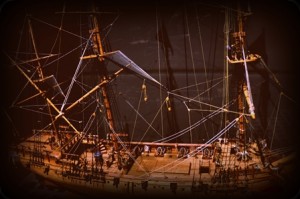 Nearly 300 years ago today, on April 26, 1717, the pirate ship Whydah, under the command of Samuel Bellamy, approached Cape Cod, Massachusetts. The Whydah was originally a slaving ship, captured by Bellamy in the Caribbean in February, with more than 130 men aboard and mounted with 23 guns. On the morning of April 26, the pirates captured a pink, a large vessel with two or three masts and a distinctive narrow, rounded stern, which was on its way from Boston to New York. Bellamy sent seven of his men aboard the pink, the Mary Anne from Ireland, with orders to follow him. But those pirates “drank plentifully” of the wine they found aboard the pink, which meant their leadership of the vessel they had taken charge of was half-hearted, at best.
Nearly 300 years ago today, on April 26, 1717, the pirate ship Whydah, under the command of Samuel Bellamy, approached Cape Cod, Massachusetts. The Whydah was originally a slaving ship, captured by Bellamy in the Caribbean in February, with more than 130 men aboard and mounted with 23 guns. On the morning of April 26, the pirates captured a pink, a large vessel with two or three masts and a distinctive narrow, rounded stern, which was on its way from Boston to New York. Bellamy sent seven of his men aboard the pink, the Mary Anne from Ireland, with orders to follow him. But those pirates “drank plentifully” of the wine they found aboard the pink, which meant their leadership of the vessel they had taken charge of was half-hearted, at best.
Making matters worse, the weather deteriorated throughout the day. The men aboard the pink had been told to follow Bellamy, in the Whydah, but by about four o’clock that afternoon, there was almost no way for the vessels to see each other in the “very thick, foggy” weather. That night, sometime after 10 o’clock, a horrendous storm struck, bringing lightning and heavy rain. The storm pushed the pink Mary Anne close to an island that was, at the time, located just off what is today Nauset Light. The Whydah was about four miles north, off the coast of Marconi Beach not far from the Marconi Wireless Station. At some point during the night the Whydah was slammed into the shallow sand off the coast and sunk to the bottom of the sea floor.
There are two notable epilogues to the Whydah sinking:
1) A team of divers led by Barry Clifford discovered the Whydah wreck on the ocean floor about three decades ago, and they continue to pull up gold, weapons, and other incredible artifacts — many of which are on display at the Pirate Museum in Provincetown, MA (see www.nationalgeographic.com/whydah).
2) Only two of more than 130 men aboard the Whydah survived — an “Englishman” named Thomas Davis and the other, according to newspaper reports and trial records, was an “Indian” named John Julian. Davis was tried in Boston, but acquitted because we was a forced captive. It is widely assumed (and written) that Julian is the same Julian the Indian who, as a runaway slave, was convicted of murder and executed on Boston Neck in a snowstorm sixteen years later. But there’s no conclusive proof that is true. You can read my column in today’s Cape Cod Times on the anniversary of the Whydah sinking: www.capecodonline.com
As I note in my new book, At the Point of a Cutlass, the captive and castaway Philip Ashton almost certainly heard about the Whydah sinking just weeks after it happened, as the repercussions were felt in his home town of Marblehead, as well.






